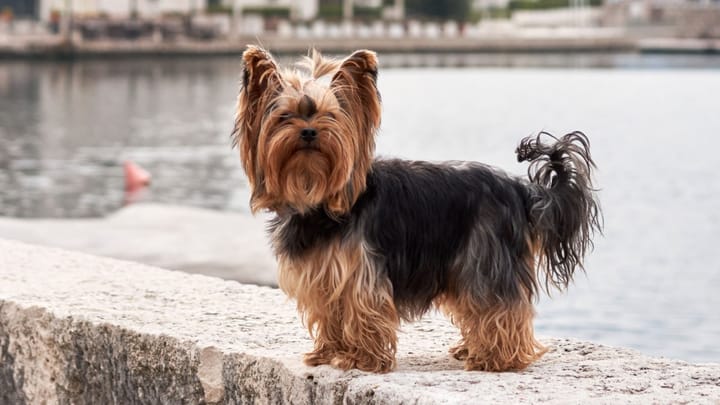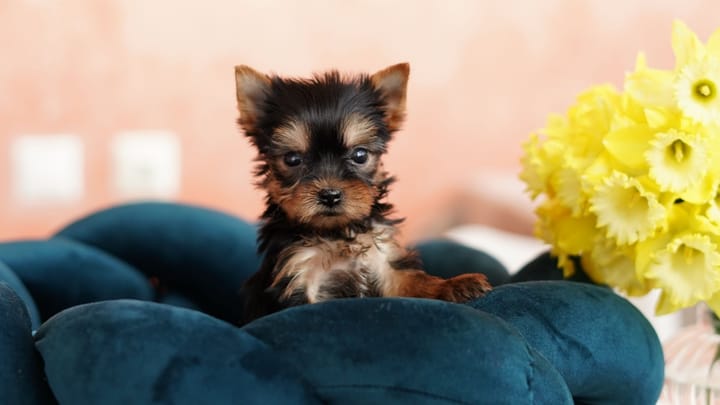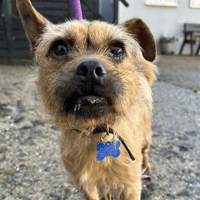Yorkshire Terrier
Other names : Yorkie, York


Yorkshire Terriers are lively, intelligent dogs that deserve respect as true terriers, not toys. Best suited to families with gentle, respectful children, they make excellent companions. Originally bred as rat hunters, they remain alert and vocal, making them effective watchdogs. Though now often seen in shows or as pets, they’re the smallest but boldest of the terrier group.
|
Life expectancy |
The Yorkshire Terrier has a life expectancy of between 12 and 17 years |
|
Temperament |
|
|
Size |
Small
|
|
Adult size |
Female
Between 6 and 10 in
Male
Between 6 and 10 in
|
|
Adult weight |
Female
Between 4 and 7 lb
Male
Between 4 and 7 lb
|
|
Coat colour
Dark steel blue from the occiput to the top of the tail, which should never be mixed with fawn, dark, or tan hair. A vivid red-brown on the chest. All the reddish-brown hair is darker at the roots than at the ends, getting lighter in a gradual gradient. |
Brown Red Blue |
|
Type of coat
The coat is long. The coat is straight, shiny, of fine and silky texture, without ever being wavy or wooly. |
Long |
|
Eye colour
The eyes are dark. |
Brown
|
|
Purchase price |
The Yorkshire Terrier costs between £510 and £670 |
This breed is extremely popular, which has led to an increased production of low-quality dogs. It is vital to seek out the best breeders in order to adopt an authentic Yorkie rather than a dog that simply resembles him.
More details about the Yorkshire Terrier
Yorkshire Terrier: Origins and history
The breed is quite recent since it has first emerged in the beginning of the 19th century, around the time of the industrial revolution. In fact, wool workers migrated from Scotland to Yorkshire, taking their dogs with them. There are, however, no surviving documents that fully explain their origins. It is nevertheless more or less certain that various Terriers like the Skye, Cairn, Clydesdale (extinct today) and the “Melita Terrier” (today’s Maltese Dog) have contributed to his formation. Initially bred to hunt for rats in the mines and for rabbits in the burrows, he is nowadays regarded exclusively as a toy terrier. Initially dubbed “Miniature Terriers”, it is in 1886 that the Kennel Club officially recognised the breed in its own right as the “Yorkshire Terrier”. The first official breed standards had been established towards the end of the 19th century, in 1898.
Physical characteristics of the Yorkshire Terrier
The Yorkshire Terrier is a dog of compact and balanced constitution, carrying himself upright and exuding an air of importance. His build is generally robust and proportional. The head is rather small and flat, with a skull not too round and a rather short muzzle. The eyes are of medium size, shiny, cast in a straight direction. The ears are small and v-shaped, erect and covered in shorter and duller red-brown hair. The limbs are perfectly straight. The tail is densely covered by hair and carried above the level of the back.
Yorkshire Terrier: Characteristics
Yorkshire Terrier: Behaviour
Training a Yorkshire Terrier
Despite his small size, the Yorkie is a dog with a strong personality who necessitates a firm and consistent training.
It is therefore necessary to implement some rules of life and clear boundaries to be respected as soon as the Yorkshire Terrier pup first integrates the home, in order to stop bad habits from developing.
You also shouldn’t think that a dog of this size does not need to be trained- small or big, all dogs need to learn some basic discipline not only to integrate the household as seamlessly as possible, but also to adapt well to society in general.
Yorkshire Terrier: Lifestyle
Breed compatibility Yorkshire Terrier
Yorkshire Terrier: Purchase price
The price of a Yorkshire Terrier varies depending on its origins, age, and gender. You have to count an average of £670 for dogs registered at the Kennel Club.
With regards to the monthly budget required to meet the needs of a dog of this size, you have to estimate an average of £20 per month.
Yorkshire Terrier: Shedding
Average
The Yorkie experiences moderate hair loss- it will be necessary to brush him on a daily basis during moulting seasons (autumn and spring), in order to remove any dead hairs.
Yorkshire Terrier: Grooming
The Yorkshire Terrier’s coat requires consistent and meticulous care. It is recommended to take them to a professional dog groomer regularly, as their hair grows continuously at a rate of around 0.4 inches per month.
Regular trims are essential to prevent the coat from becoming tangled or obstructing their movement.
For those keeping Yorkshire Terriers as companions rather than show dogs, trimming the hair enough so it doesn’t touch the ground can help with maintenance while ensuring the coat remains manageable.
Regular brushing is also necessary to keep their coat clean and looking its best.
Additionally, their eyes, ears, and teeth should be checked and cleaned regularly, and their nails should be clipped or filed as needed.
Yorkshire Terrier: Health
The average life expectancy is estimated at 15 years.
Even though he appears fragile, this little dog is robust and can enjoy a very long life in spite of his predisposition to certain diseases.
Even though he is less sensitive to the heat than to the cold, the Yorkshire Terrier should not be physically overstimulated during heatwaves. Early-morning and late-night walks should take priority during such periods.
Lacking an undercoat, this dog is vulnerable to bad weather (cold and humidity).
Rather active by nature, if he is provided with a nutritional regimen adapted to his needs, as well as sufficient exercise, the York will not fall victim to excessive weight. Be careful, however, as one really tends to spoil toy dogs in particular!
- Patent ductus arteriosus (cardiac malformation)
- Mitral endocardiosis (degenerative disease of certain heart valves)
- Color dilution alopecia (faulty development of the coat and subsequent loss of coat)
- “Leather ear” (symmetrical hair loss and hyperpigmentation of the muzzle and ears)
- Cushing’s disease (hypercorticism)
- Urinary stones
- Hydrocephalus
- Atlanto-axial subluxation
- Eye afflictions (cataract, dry eye, retina disorders, etc.)
- Congenital dislocation of the elbow
- Patellar luxation
- Aseptic necrosis of femoral heads
- Tracheal collapse (respiratory disease)
- Undescended testis (testicular development anomaly)
- Complications during labour





